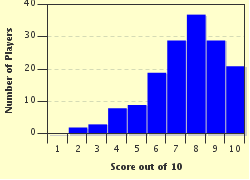Quiz Answer Key and Fun Facts
1. Winners of the ancient Olympic games were awarded with which of these symbols?
2. Who founded the International Olympic Committee in 1894?
3. Which Greek Goddess of Victory has featured on the winning Olympic bronze, silver and gold medals?
4. Designed in 1912, what do the five rings on the Olympic flag symbolise?
5. The Olympic torch relay has featured during Olympic Games, but at which venue did it make its first appearance?
6. Jean Jacoby from Luxembourg was a gold medallist in the 1924 and 1928 Olympics. In which competition did he enter?
7. Diaulos and dolichos were ancient Olympic competitions comparable to which modern sport?
8. Which of these sports featured in the ancient Olympic Games?
9. Pankration was an ancient sport in the Olympic Games. What is its more common name?
10. "Spirit in motion" is the motto for which sporting movement first hosted in Rome in 1960?
Source: Author
Plodd
This quiz was reviewed by FunTrivia editor
gtho4 before going online.
Any errors found in FunTrivia content are routinely corrected through our feedback system.


